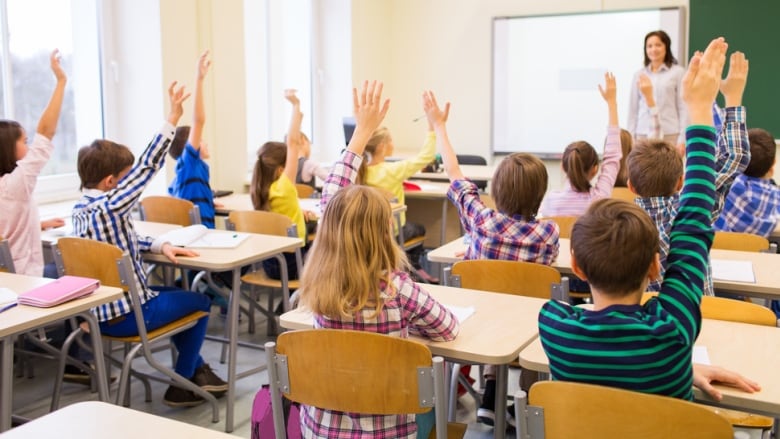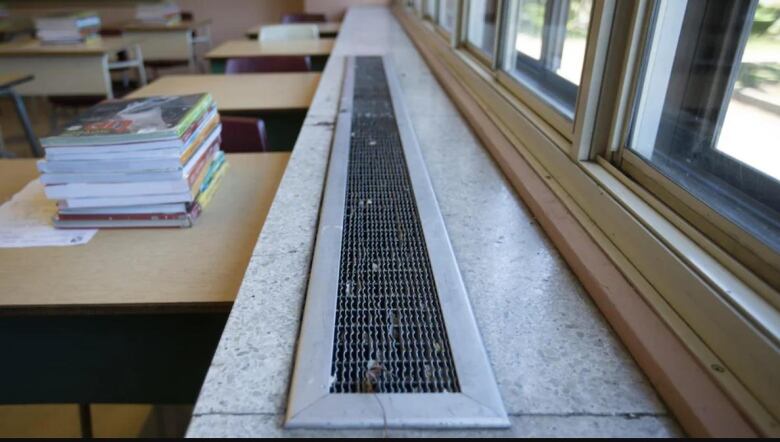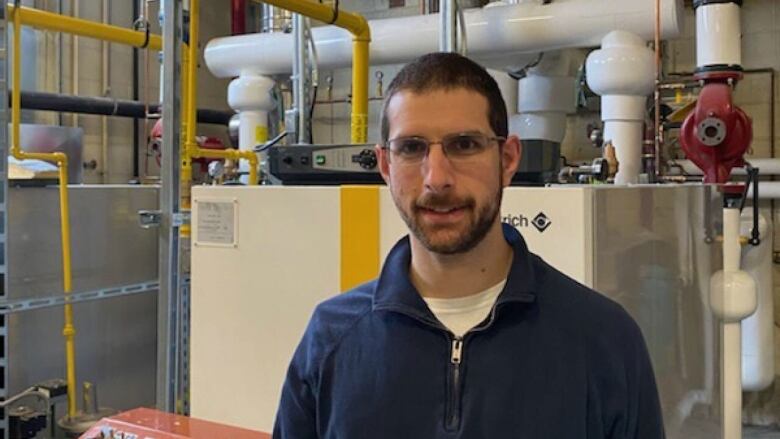Teachers have concerns as they learn about air quality in N.B. schools
Nearly 83% of schools tested last winter exceeded peak CO2 limits, Department of Education results show

New Brunswick teachers are learning about air quality and want more transparency about how it's monitoredin school.
The issue came into focus during the COVID-19 pandemic and was the subject of a recent virtual NetworkEd session put on by the New Brunswick Teachers' Association.
"The pandemic helped increase awareness about an issue that has been increasingly more concerning as more and more schools were built without windows that open and aging ventilation and building infrastructure,"Peter Legacy, president of the association,said in an emailed statement.
In the winter of 2022-23, the most recent air quality results available,29 of the 35 public schoolstested had peak carbon dioxide levels above the Department of Education's threshold of1,500 parts per million (ppm).
The highestwas more than double that3,418 ppm at Anglophone West District'sGeorge Street Middle School in Fredericton, which also had the highest average reading, at 1,709 ppm.
Carbon dioxide, or CO2, is an odourless, colourless, non-flammable gas commonly created indoors when people exhale.
It'sused as a proxy to measure air quality and the rateat which air is being renewed, which can also serve as a warning sign about the risk of spread of COVID-19 and other respiratory illnesses, according to experts.
'Many questions'
During the introductory virtual session hosted by the association, a small group of teachers considered the following questions, Legacy said:
- What do we already know?
- What more do we need to know or do as a result?
- What is the next best first step this "Network" should take as a result?
The teachers had many questions and decided the next step should be a webinar for members,he said. Legacy did not indicate when the followup session will be held.
NetworkEdispart of a new initiativethis year to "engage members on topics that may be of interest to learn more about together," according to Chantal Lafargue, the association's director of communications.
Other inaugural sessions includedsocial media, provincial governance and policy, and artificial intelligence in education, she said.
No 'immediate risk' to occupants
The Department of Education plans to conduct annual air quality tests at certain schools again this winter, according to spokesperson Charles Renshaw.
"The government is committed to ensuring all school environments in the province are healthy, safe, and optimal for learning and working," he said in a recent emailed statement.
Tests are conducted on a single day in about 10 per cent of classrooms per school over an eight-hour period of a regular school day, the department has previously said.
The list of schools to be tested will be provided to the school districts, said Renshaw. Asked when the list will be made public, he replied that the test results will be posted online by the end of the summer.
Typically, the department tests schools without mechanical ventilation systems that had peak readings over 1,500 ppm the previous year.

Renshaw said the results "are available to the districts and can be shared with schools and parents if requested."
Asked to comment on the 2022-23 results, Renshaw said they are "consistent with previous testing and do not show an immediate risk to occupants."
An immediate risk would require exposure to CO2 values of either 5,000 ppm for the duration of the day, or 30,000 ppm for a duration of 15 minutes, he said.
"Exposure to elevated levels of CO2 may result in an increased risk of acute health effects such as dizziness, headaches and tiredness."
No guidance on school CO2 averages
But it's not really about the safety of the CO2 levels themselvesCO2 is a tool to gaugeoverall air quality,an Ontarioexpert on indoor air quality has pointed out.
The Department of Education has set 1,500 as the "peak desirable CO2reading" for schools, in consultation with WorkSafeNB and the Department of Transportation and Infrastructure.
Joey Fox, a heating, ventilation and air-conditioning engineer and chair of the Ontario Society of Professional Engineers' air quality advisory group, however,describesthat level as"very poor."
It would "be indicative of really the range where you would expect what's called 'sick building syndrome,'" plus the risk of disease transmission is "much, much higher,"Fox has said.
Hecontends school averages are a more important measurement andshould be no higher than 1,000 ppm. Around 800 ppm is better.

Nineteen of the 35 schools tested last winter had averages over 1,000 ppm, and 27 were above 800 ppm, according to theresults ofResearch and Productivity Council and Alltech, which were submitted to the department between March and May, and posted on its website Sept. 15, after beinganalyzed,formatted and packaged.
"All test results to date have been within WorkSafeNB and Public Health guidance and have not posed a risk to occupants' health and safety," the department spokesperson said.
The department's website states:"WorkSafeNB guidance indicates CO2 levels below 5,000 ppm over an eight-hour period weighted average, or 30,000 ppm over a 15-minute weighted average do not pose risks to occupants' health and safety."
Pressed on what WorkSafeNB recommends the average CO2 readings in schools should be, Renshaw replied: "WorkSafeNB does not provide guidance on average CO2 readings."
As for Public Health guidance on school CO2 peaks and averages? "Public Health supports the adopted air quality threshold used by WorkSafeNB and the Department of Transportation and Infrastructure," he said.
Eleven schools were slated to receive ventilation systems this year, Education Minister Bill Hogan told the legislature in April.
Six are now expected to be delayed until 2024, said Renshaw. They include:Birchmount, Frank L. Bowser School, Dorchester Consolidated School, Nackawic Senior High School, Marshview Middle School and Blacks Harbour.
"All infrastructure projects have the potential to be impacted by unforeseen delays, including delays related to system design and material delivery, as well as those related to workforce availability and site access," he said.
Goal of 10 to 12 school upgrades in 2024
There are 28 other schools that need new ventilation systems,Hogan has said. Priority projects for 2024 have not been released.
They are usually determined in the spring, based on the latest air quality results, said Renshaw.
"Schools with higher levels of peak CO2 and the number of samples above 1,500 ppm (i.e. average) are prioritized to begin the process to install a new mechanical ventilation system," he said. "Once a project is started, it is seen through to completion."
The goal is tocomplete 10 to 12 school ventilation projects a year, said Renshaw, "however constraints on design, manufacturing and construction limit the number that can successfully be completed in a fiscal year.
Work is progressing as quickly as possible.- Charles Renshaw, Department of Education spokesperson
"Once a system is designed, it is tendered for construction. Based on the complexity of the project, and the available construction window in a school when it is vacant, the installation phase could take up to two years."
Some critics have argued the government isn't moving quickly enough to address the potential risks, but the department has no plans to step up its timeline, according to Renshaw.
The department is following a multi-year program to ensure all schools are equipped with mechanical ventilation systems by the end of 2026, or the schools themselves are replaced.
"Work is progressing as quickly as possible," Renshaw said.

In the meantime, all classrooms in schools without a ventilation system are equipped with portable HEPA filters, he noted.
Corsi-Rosenthal boxes homemade air purifier systems made from fourfilters taped together to form a cube, with a box fan taped on top, remain prohibited.
Richard Corsi, the dean of engineering at the University of Californiawho co-created the design, recently took to social media to publicly challengethe province's position and offered to speak with government officials about the issue.
The department won't be taking him up on the offer, said Renshaw. "There is no need to add any additional filtration," he said.












_(720p).jpg)


 OFFICIAL HD MUSIC VIDEO.jpg)
.jpg)



























































































